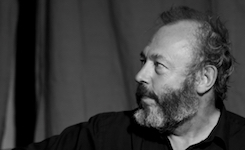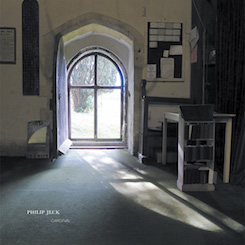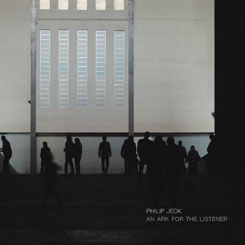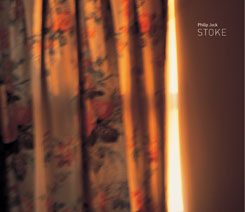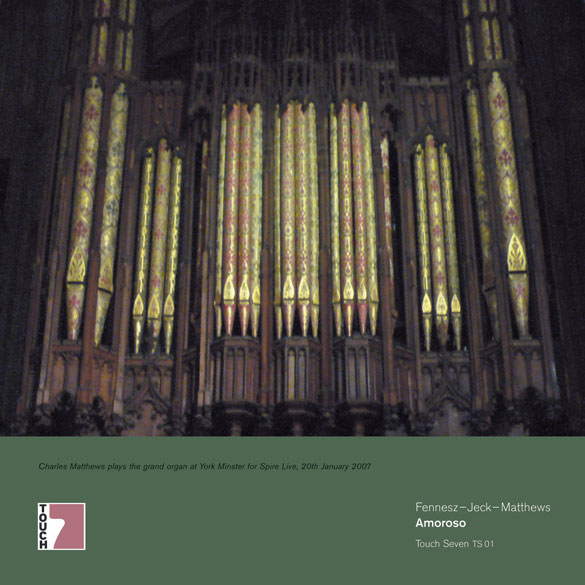
7″ vinyl only
Track listing:
Side a:
Fennesz/Matthews 3′ 34″
Side b
Jeck/Matthews 3′ 24″
cut by Jason @ Transition
artwork and photography by Jon Wozencroft
Am`o`ro´so
n. 1. A lover; a man enamored.
adv. 1. (Mus.) In a soft, tender, amatory style.
Charles Matthews plays the Grand Organ in York Minster, during Spire Live on 20th January 2007. This release is a homage to Arvo Pärt… Arvo Pärt is often identified with the school of minimalism and more specifically, that of “mystic minimalism” or “sacred minimalism”. He is considered a pioneer of this style, along with contemporaries Henryk Górecki and John Tavener.
7″ vinyl was the quintessential format for popular music. Today, it is an undervalued and mostly promotional medium, used as a fetishistic signpost to a time of musical authenticity and a “healthy” popular culture. It might seem like another retrograde step to launch a vinyl series just as the download format threatens to dominate, and indeed there is an element of “the rear view mirror”… the generation of Touch artists who grew up with vinyl [and cassette] still feeling a strong emotional attachment to it. This series is more than that… an overtly critical, non-digital statement is supported by treatments of audio work which cannot be applied to digital formats – the sonic texture, the use of a locked groove, the A & the B and the additional dimension of the visual counterpoint. As for the aspect of audience participation, we choose not to specify the RPM on the label, encouraging the listener to experiment with playback options and personal preferences. An attempt to make music that works at both speeds. The front cover might actually be the back cover…
About the players:
Charles Matthews: “I felt you were pure music, not human flesh, music through time, music played from the Universe, without boundaries.” [an audience member, July 2007] Born in 1966, Charles Matthews studied at the Royal College of Music, London, and was an organ scholar at Trinity College, Cambridge. His teachers have included Beryl Tichbon, Gwilym Isaac, David Pettit, Patricia Carroll, Nicholas Danby, Charles Spinks and Dr Richard Marlow.
Charles pursues a varied career as pianist, organist, composer and teacher, performing and broadcasting for radio and television within the UK and internationally. He has won numerous awards, perhaps most notably the first prize in the 1999 Franz Liszt Memorial Competition in Budapest. His recordings have been issued by Olympia, Priory, Guild and Touch; he is the organist for the Touch project, Spire, which also includes Christian Fennesz and Philip Jeck.
Christian Fennesz: Fennesz uses guitar and computer to create shimmering, swirling electronic sound of enormous range and complex musicality. “Imagine the electric guitar severed from cliché and all of its physical limitations, shaping a bold new musical language.” – (City Newspaper, USA). His lush and luminant compositions are anything but sterile computer experiments. They resemble sensitive, telescopic recordings of rainforest insect life or natural atmospheric occurrences, an inherent naturalism permeating each piece. He lives and works in Vienna and Paris.
Philip Jeck: Philip Jeck studied visual art at Dartington College of Arts. He started working with record players and electronics in the early ’80’s and has made soundtracks and toured with many dance and theatre companies as we as well as his solo concert work. His best kown work “Vinyl Requiem” (with Lol Sargent): a performance for 180 ’50’s/’60’s record players won Time Out Performance Award for 1993. He has also over the last few years returned to visual art making installations using from 6 to 80 record players including “Off The Record” for Sonic Boom at The Hayward Gallery, London [2000].
Philip Jeck works with old records and record players salvaged from junk shops turning them to his own purposes. He really does play them as musical instruments, creating an intensely personal language that evolves with each added part of a record. Philip Jeck makes geniunely moving and transfixing music, where we hear the art not the gimmick.













